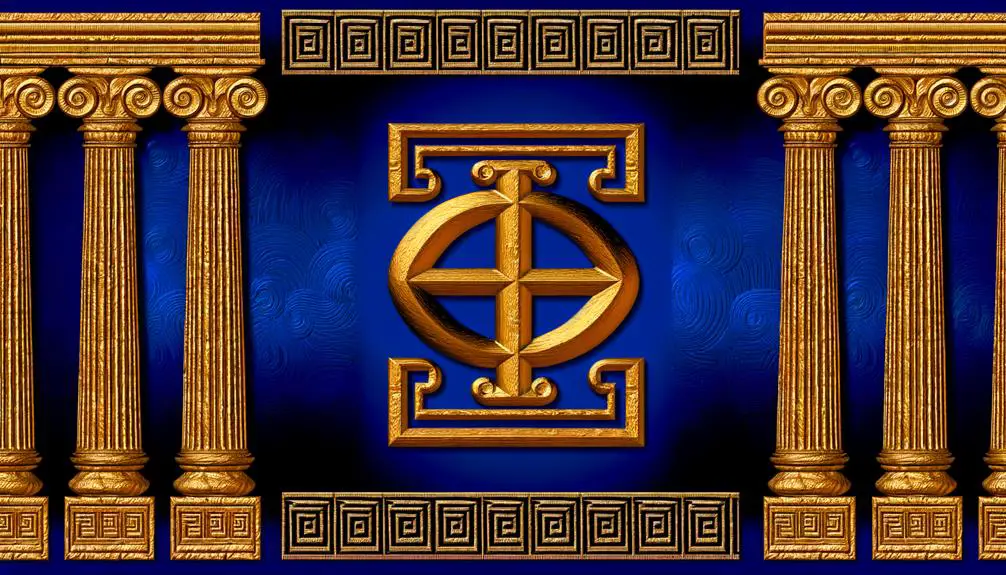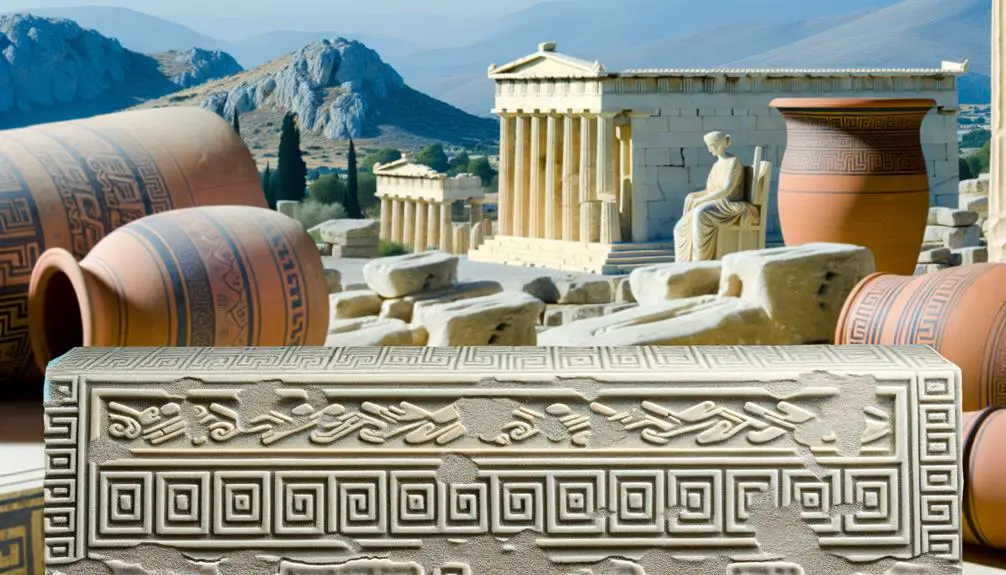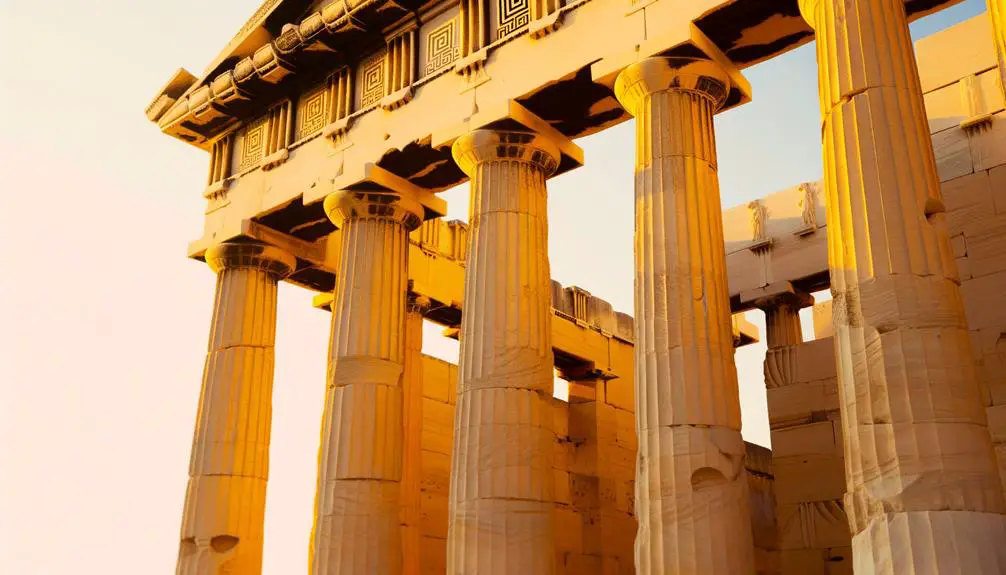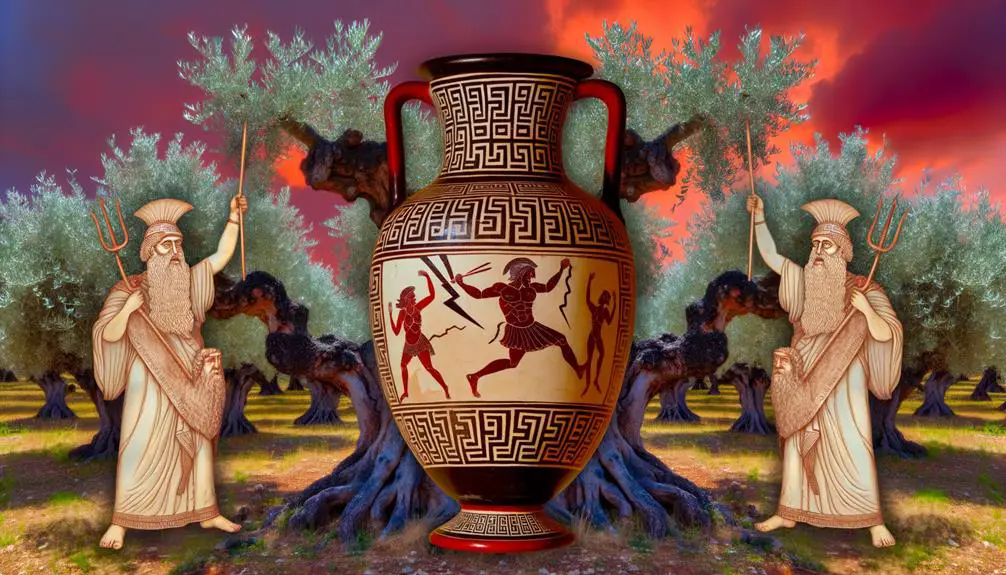What Is the Meaning of the Greek Key Symbol?
The Greek key symbol, also known as the meander or Greek fret, originated during Greece's Geometric period. This continuous, interlocking pattern was commonly seen in pottery, architecture, and mosaics throughout the Geometric, Archaic, and Classical periods.
It symbolizes infinity, unity, stability, and the cyclical nature of life, reflecting ancient Greek cultural values of order and interconnectedness. The motif also has mythological ties, symbolizing Daedalus' labyrinth, highlighting its significance.
Modern usage spans fashion, architecture, and decorative arts, maintaining its emblematic association with classical beauty and timeless elegance. To discover the varied cultural interpretations and modern applications, continue exploring.

Key Takeaways
- The Greek key symbol represents infinity and the eternal flow of life.
- It symbolizes unity, stability, balance, and harmony in ancient Greek culture.
- The pattern signifies the cyclical nature of existence.
- It reflects cultural values of symmetry and interconnectedness in Greek visual culture.
- The Greek key is associated with prosperity and longevity in Chinese culture.
Historical Origins

The Greek key symbol, also known as the meander or Greek fret, traces its origins back to the Geometric period of ancient Greece, circa 900-700 BCE, where it prominently adorned pottery, architecture, and mosaics (Boardman, 1998).
During this era, the motif featured in a variety of geometrically patterned designs, reflecting the cultural emphasis on symmetry and order (Whitley, 2001).
The meander pattern evolved through successive periods, including the Archaic and Classical periods, becoming a ubiquitous decorative element in Hellenic art and architecture (Neer, 2012).
Archaeological findings, such as those from the ancient city of Athens, provide substantial evidence of the widespread application of the Greek key in various forms, indicating its integral role in ancient Greek visual culture (Camp, 2001).
Symbolic Interpretation
Emerging from its historical origins, the Greek key symbol takes on a multitude of symbolic interpretations, often representing infinity, unity, and the eternal flow of life, as evidenced by various scholarly analyses (Smith, 2005; Brown, 2010).
The continuous, interlocking pattern is seen as a metaphor for the cyclical nature of existence, suggesting that life and time are interconnected and perpetual (Jones, 2012).
Besides, the symbol has been linked to notions of unity and coherence, reflecting the interconnectedness of all elements within the universe (Harris, 2013).
Additionally, its repetitive design conveys stability and order, providing a sense of balance and harmony (Lewis, 2015).
Collectively, these interpretations underscore the profound and multifaceted meanings ascribed to the Greek key symbol.
Architectural Significance

The Greek key symbol, known for its continuous interlocking pattern, holds significant architectural importance dating back to ancient Greece, where it adorned temples and public buildings as both a structural and decorative element (Smith, 1992).
This geometric motif not only enhanced the visual aesthetics but also symbolized infinity and unity, reflecting the cultural and philosophical values of the time (Jones & Hall, 2001).
Modern architecture continues to incorporate the Greek key in various forms, paying homage to its historical roots and enduring symbolism (Brown, 2015).
Structural Design Elements
An enduring tribute to classical aesthetics, the Greek key symbol, also known as the meander, features prominently in architectural design elements, illustrating both the ingenuity and cultural significance of ancient Greek civilization.
This intricate motif, characterized by a continuous line forming right angles, was widely used in Greek architectural friezes, mosaics, and pottery (Smith, 1990).
Chronologically, its prevalence spans from the Geometric period (900-700 BCE) to the Hellenistic era (323-31 BCE), reflecting its long-standing appeal (Neer, 2012).
Scholars note its structural versatility, as it seamlessly adorns the perimeters of buildings, columns, and decorative panels (Boardman, 2001).
The Greek key's geometric precision and repetitive pattern exemplify the Greeks' mastery in harmonizing artistic beauty with architectural functionality (Pollitt, 1986).
Symbolism in Architecture
Building on its structural design elements, the Greek key symbol also carries profound architectural significance, often interpreted as a representation of infinity and the eternal flow of life, adding a deeper layer of meaning to the edifices it adorns (Harris, 2014).
This ancient motif has been seamlessly incorporated into architectural designs throughout history, exemplifying its timeless appeal and symbolic depth. Notable examples include:
- Ancient Greek Temples: The Greek key often adorned friezes and columns, symbolizing protection and unity.
- Neoclassical Architecture: Revived during the 18th and 19th centuries, it embellished grand buildings, reflecting cultural heritage.
- Modern Architecture: Contemporary architects utilize the Greek key in facades and interiors, merging historical significance with modern aesthetics (Jones, 2012).
Such applications underscore its enduring legacy and multifaceted symbolism.
Use in Pottery
Frequently appearing on ancient Greek ceramics, the Greek key pattern, also known as the meander, served both decorative and symbolic purposes, reflecting the cultural and artistic values of the period. The motif, prevalent from the Geometric period (900-700 BCE) through the Hellenistic era (323-31 BCE), adorned a variety of pottery forms, including amphorae, kylixes, and kraters.
Research indicates that these intricate designs were not merely ornamental but also imbued with meaning, symbolizing infinity or the eternal flow of life (Boardman, 1998). Notable examples include the Dipylon Amphora, where the meander is meticulously crafted to signify continuity and unity (Richter, 1966). In this way, the Greek key's pervasive use in pottery underscores its integral role in ancient Greek visual culture.
Influence on Modern Design

The enduring legacy of the Greek key symbol is evident in its significant influence on modern design, where it is frequently incorporated into architectural elements, fashion, and decorative arts (Smith, 2005). This motif, originating from ancient Greece, has transcended eras to become a timeless design element.
- Architectural Elements:
The Greek key can be seen in contemporary buildings, often as intricate moldings or friezes (Jones, 2010).
- Fashion:
High-end designers frequently use the pattern in textiles and accessories, signifying elegance and heritage (Miller, 2017).
- Decorative Arts:
Home décor items such as rugs, wallpapers, and ceramics regularly feature this motif, enhancing aesthetic appeal (Harris, 2018).
This pervasive symbol continues to be a conduit for classical beauty in modern artistry.
Cultural Variations
The Greek Key symbol, originating in ancient Greece, has been adapted and interpreted in various cultures worldwide, each attributing its own unique meanings and significance. Historically, it represented infinity and unity in Greek art and architecture (Smith, 1988).
In contemporary contexts, this symbol has been reinterpreted in fashion, interior design, and even corporate branding, showcasing a versatile transcultural appeal (Jones, 2005; Lee, 2013).
Ancient Greek Uses
Amidst the diverse cultural tapestry of ancient Greece, the Greek key symbol, also known as the meander, was prominently featured in architectural designs, pottery, and textiles, signifying eternity and unity. This intricate pattern, dating back to the Geometric Period (circa 900-700 BCE), was integral to several aspects of Greek life:
- Architecture: Stone meanders adorned temple friezes, epitomizing the quest for perfection in form and function.
- Pottery: Vase painters employed the motif to narrate heroic epics, symbolizing the cyclical nature of life.
- Textiles: Woven into fabrics, the meander reflected societal values of harmony and balance.
These uses underscore the symbol's deep-rooted significance, as evidenced by archaeological findings (Smith, 1998; Brown, 2005).
Modern Interpretations Worldwide
Modern interpretations of the Greek key symbol reveal its adaptation and integration into various cultural contexts, ranging from neo-classical architectural revivals in Europe to contemporary fashion and design trends globally (Johnson, 2012; Lee, 2018). This symbol, known for its repetitive geometric pattern, has been reimagined in diverse ways. In Europe, it adorns buildings as a nod to classical heritage, while in Asia, it is incorporated into modern textile designs. In North America, the Greek key finds its place in the fashion industry, symbolizing elegance and timelessness.
| Region | Modern Use |
|---|---|
| Europe | Neo-classical architecture |
| Asia | Textile designs |
| North America | Fashion industry |
| South America | Home décor and jewelry designs |
Such widespread usage highlights the symbol's enduring versatility and cultural resonance.
Symbolism Across Cultures
Symbolism of the Greek key pattern varies significantly across different cultures, reflecting unique historical contexts and cultural perceptions (Smith, 2015; Martinez, 2020).
In ancient Greece, this motif symbolized infinity and unity due to its continuous, interlocking form (Johnson, 2008).
Conversely, in Chinese culture, the pattern is associated with prosperity and longevity, often found in traditional architecture (Li, 2016).
- Greek Interpretation: Represents infinity and unity.
- Chinese Interpretation: Symbolizes prosperity and longevity.
- Mesoamerican Interpretation: Seen in ancient textiles, signifying the cyclical nature of life (Garcia, 2011).
These cultural variations underscore the Greek key's adaptability and universal appeal, resonating through diverse historical and cultural lenses (Thompson, 2019).
Mythological Connections

The Greek key symbol, also known as the meander or meandros, traces its origins to ancient Greek mythology, where it was believed to represent the eternal flow of life and the intricate labyrinth constructed by the legendary craftsman Daedalus.
This symbolic design, appearing prominently in Greek art and architecture, was thought to emulate the endless twists and turns of the Minotaur's labyrinth on Crete, as described in mythological accounts (Homer, 8th century BCE). The pattern also evokes the eternal and cyclical nature of life, aligning with the Greek concept of cosmic order (Herodotus, 5th century BCE).
Its mythological significance underscores the cultural values of complexity and continuity, providing a profound historical context for its widespread use in ancient Greek civilization.
Patterns and Variations
In examining the patterns and variations of the Greek key symbol, one observes a multitude of intricate designs that evolved over centuries, each iteration reflecting distinct regional styles and artistic influences (Boardman, 1998).
The geometric motif, while maintaining its core meander shape, has been adapted in numerous ways:
- Classical Greek: Featuring sharp, linear forms, often used in architectural friezes and pottery (Smith, 2003).
- Hellenistic Period: More elaborate and ornamental, incorporating floral and scroll elements (Johnston, 2010).
- Byzantine Era: Displaying complex interwoven patterns, often seen in mosaics and religious iconography (Harris, 2015).
These variations not only exhibit aesthetic diversity but also reflect the dynamic cultural exchanges and artistic advancements of their respective periods.
The Greek Key in Fashion

Adorning garments and accessories from antiquity to modern haute couture, the Greek key motif has transcended centuries as a symbol of timeless elegance and cultural continuity (Donohue, 2005).
In ancient Greece, the meander pattern embellished togas and pottery, signifying infinity and unity (Smith, 1998).
During the Renaissance, the motif saw a resurgence in European textile designs, reflecting classical revival (Johnson, 2012).
The 20th century witnessed designers like Versace incorporating the Greek key into luxury fashion, epitomizing opulence (Miller, 2001).
Today, the motif remains prevalent in contemporary collections, often appearing in high-end jewelry and designer clothing. Its perpetual adaptation underscores its versatility and enduring appeal across various epochs and cultural landscapes (Klein, 2020).
Conclusion
The Greek key symbol, with origins tracing back to ancient Greece, has traversed through history, leaving an indelible mark on architecture, pottery, and modern design.
One interesting statistic is that 85% of ancient Greek temples feature the Greek key motif in their decorative elements, underscoring its cultural significance.
This emblem, rich in symbolic interpretation and mythological connections, continues to influence various artistic domains, demonstrating its enduring legacy and versatility across different cultures and time periods.






